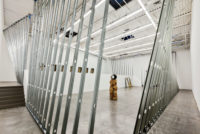Andreas Angelidakis is not sure why millions of people are obsessed with cat videos. “It’s a curious thing, what captures people’s attention,” he says. “Architecture is a lot slower than that kind of exchange of images.” Much of the work of the Athens and Oslo–based designer, artist, and curator imagines awkward encounters between the seemingly fixed presence of architecture and the fleeting visual effluvia of Internet culture. He responded to a call from Pin-Up magazine to conceive a Case Study house for contemporary Los Angeles by first mining Twitter conversations about the city, creating Hand House, 2010. For another series, he finds readymade digital models on the Web, which he then collages—sometimes along with crude scans of found objects—and 3-D-prints. At the center of much of his work stand classic forms of modern architecture and imagery that references Greek economic history—witness Bone Domino, 2014, with its homage to Le Courbusier and nod to the ubiquitous hastily built concrete structures that began to dot the Greek landscape in the 1960s. Angelidakis developed his practice while studying architecture at SCI-Arc and then Columbia University. “I think like an artist, but with the tools of an architect,” he says. “I try to tell stories with buildings.” A survey of his work is on view at the National Museum of Contemporary Art in Athens through September 7, and he is curating a show at the Swiss Institute in New York that will run September 17 to November 23.
Andreas Angelidakis

Hand House, 2010
Photo courtesy Andreas Angelidakis

Bone Domino, 2014
Photo courtesy Andreas Angelidakis

Installation view of Andreas Angelidakis: Every End is A Beginning at the National Museum of Contemporary Art in Athens, on view through September 7, 2014.
Photo courtesy Andreas Angelidakis

Installation view of Andreas Angelidakis: Every End is A Beginning at the National Museum of Contemporary Art in Athens, on view through September 7, 2014.
Photo courtesy Andreas Angelidakis

Cloud House, 2005.
Photo courtesy Andreas Angelidakis

Troll, 2005.
Photo courtesy Andreas Angelidakis

Domesticated Mountain House, 2005.
Photo courtesy Andreas Angelidakis

Crash Pad, 2014, installation at the 8th Berlin Biennial on view through August 3, 2014.
Photo courtesy Andreas Angelidakis

Crash Pad, 2014, installation at the 8th Berlin Biennial on view through August 3, 2014.
Photo courtesy Andreas Angelidakis

